Grotte di Onferno
Grotte dell’Infierno - Onferno Grotte - Grotta dell’Onferno
Useful Information
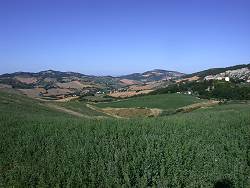
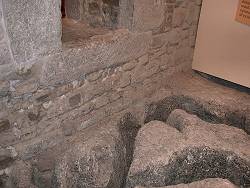
| Location: |
Via Provinciale Onferno, 50, 47855 Castello di Onferno RN.
30 km from Rimini, 30 km from Riccione, 20 km from Cattolica. Leave Autostrada A14 Bologna-Bari at exit Cattolica. Drive towards TODO then towards TODO. After 12 km turn left to Gemmano, 6 km, and follow the road to Onferno, 7 km. Alternative: follow the valley road to Mulina TODO then turn left. 4 km to Onferno. (43.873078084707640, 12.545785143473690) |
| Open: |
APR to MAY Sat 14:30-17:30, Sun 10-17:30. JUN to SEP daily 9:30-12:30, 15-19. OCT Sat 14:30-17:30, Sun 10-17:30. NOV-MAR Sun 14:30-19. [2021] |
| Fee: |
Cave tour:
Adults EUR 10, Children (0-12) EUR 8, Seniors EUR 8. Museum: free. [2021] |
| Classification: |
 Karst Cave Karst Cave
 gypsum cave. gypsum cave.
|
| Light: | none, electric torches and helmets provided. |
| Dimension: | VR=70 m, T=12-14 °C. |
| Guided tours: | D=60 min. |
| Photography: | allowed |
| Accessibility: | no |
| Bibliography: | |
| Address: |
Grotte di Onferno e Museo Naturalistico, via Provinciale Onferno 50, 47855 Gemmano (RN), Tel: +39-0541-984694, Fax +39-0541-984694.
E-mail: |
| As far as we know this information was accurate when it was published (see years in brackets), but may have changed since then. Please check rates and details directly with the companies in question if you need more recent info. |
|
History
Description
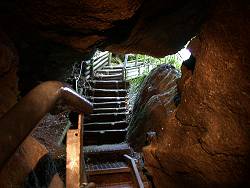
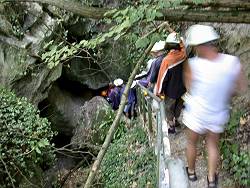
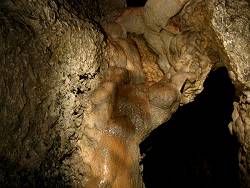
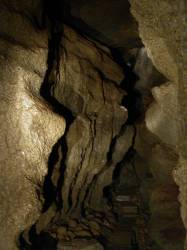
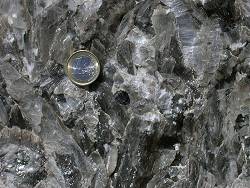
The name of the place, Grotte di Onferno, may have been chosen because of the fog which sometimes comes out of the cave. So people thought they were the entrance to hell. Onferno seems to be the local dialect word for Infierno (inferno), and is the name of the small hamlet where the cave is located.
The cave is an extraordinary interesting river cave and is, as far as we know, the only show cave in gypsum in Italy. The whole area of Onferno is an outcrop of anhydrite, which is very easily soluble by water. The solution leads to an extreme relief, rocks and cliffs, and steep, infertile, and dry slopes. These unfriendly areas give home to numerous rare specialists, plants and animals, and are thus protected. The whole area, including the cave with its bats, is a nature reserve. The information center for the reserve is located in the castle.
The cave entrance is a nice building with a tower, built of rocks. It was obviously once a part of the castle, maybe a storage room, barn or stable. Now it is completely renovated and serves as a speleological museum. The ground floor is dedicated to gypsum karst, speleology and geology of the area. The upper floor is an exhibition about bats, showing their live, breeding and death, their sonar system and the anatomy of their wings. The whole exhibition is completed by two multimedia systems with huge trackballs for children to explore. A very nice exhibition, but unfortunately only in Italian.
The visitors are equipped with helmets and electric torches, and the tour starts. The helmets are not really necessary, as there are only two or three a little low places. Most of the cave is pretty high and narrow. The electric torches are absolutely necessary. The cave has no light at all, and people who feel uncomfortable with this should relinquish this tour. But other things are not so obvious and should be noted: the floor is often a little wet, dirty and slippery. Good shoes are essential. And the cave is rather cool, so shorts and a t-shirt are not enough. The path goes uphill all the time, and you get warm by the walking, but a sweater and long trousers are nevertheless recommended.
Now we leave the entrance through the back door and follow the path through a rain forest, a damp and warm forest which even houses lianas. The guide tells, the young lianas can be eaten. After some more stops and explanations, we reach the lower end of the cave. This is the resurgence of the cave river and secluded between rocks and trees. This point is the coldest point of the tour with about 8 °C. It seems the cave gets warmer from the lower to the higher entrance. Soon after the cave entrance, the temperature is 12 °C, and this still rises to 14 °C at the upper end.
Now we enter the cave. The low ceiling is the lowest section of the cave, there are two more, but they have either at the same height or higher. We now follow the mostly dry bed of the cave river, always on a small path about 30 cm higher than the river bed. Sometimes the path is wet and slippery with mud. Only in the last part the river vanishes, and we ascend on a dry path on cave debris. An exciting part, for some visitors funny and for some cruel, is extremely narrow. The passage is only 40 cm wide and snakes uphill. And this part lasts for several meters. Many children like this part most.
The last part is the area where the pipistrelle (bats) live. It is called a nursery because the cave houses mothers and children, no male adults. Visitors are asked to turn off their lights for this section to keep the impact as low as possible. Many cave spiders on the floor wait for prey, like insects thrown away by the bats, or even dead bat children falling on the ground. Soon after we have left this area, the typical stench of the bat guano ends. A last dry part of the cave goes up quite steep to the upper entrance. Impressive cliffs are above this entrance, and the castle sits right on top of it. A small chamber beneath the cave entrance was used for a mill, obviously driven by a donkey. Rooms to store the grain were partly cut into the soft anhydrite and then closed by walls.
After a few steps we see the valley above the cave. This is a small and steep valley which has no surface drainage, all the water which rains on the area in winter and spring, runs down the cave. There are swallow holes right beneath the cave entrance. And this seasonal flooding is the reason why this cave may only be visited in summer.
A last word, as this cave is rather rough: You do not need any experience or climbing ability. But the cave is not recommended for people with claustrophobia or fears of darkness, and the visitors should be able to walk the rather strenuous tour, so it is not recommended for people with heart problems. But it is normally big fun for young families with children of any age.
 Search DuckDuckGo for "Grotte di Onferno"
Search DuckDuckGo for "Grotte di Onferno" Google Earth Placemark
Google Earth Placemark Official Website Replaced by Facebook Page
Official Website Replaced by Facebook Page Riserva naturale Onferno - Appennino Romagnolo (visited: 17-OCT-2010) (
Riserva naturale Onferno - Appennino Romagnolo (visited: 17-OCT-2010) ( )
) Index
Index Topics
Topics Hierarchical
Hierarchical Countries
Countries Maps
Maps